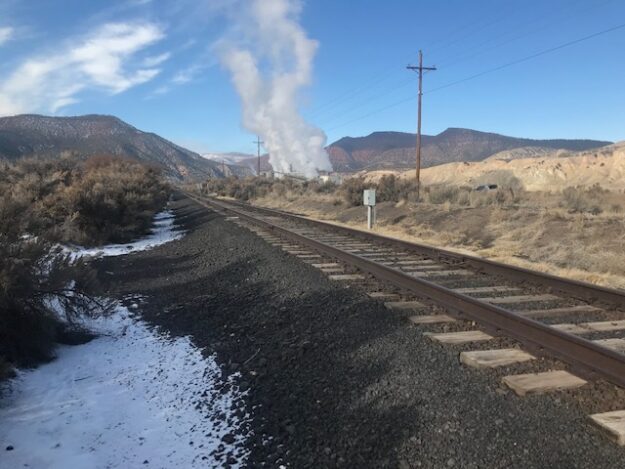Widgetized Section
Go to Admin » Appearance » Widgets » and move Gabfire Widget: Social into that MastheadOverlay zone
Commissioner candidates weigh in on idea of Tennessee Pass railroad revival

The dormant Tennessee Pass rail line at Sage near the Eagle County Regional Airport with the Gypsum wallboard plant in the background.
With no Republican running for the office in November, the District 2 seat for Eagle County commissioner being vacated by retiring Democrat Kathy Chandler-Henry will be decided in the Tuesday, June 25, Democratic primary election between Tom Boyd and Sarah Smith Hymes.
A quick scan of the campaign websites for both Boyd and Hymes shows some similarities on issues from housing to climate change to water. But where are they on a potential revival of the dormant Tennessee Pass rail line that bisects the county from Glenwood Canyon to Ski Cooper?
Since 1997, no freight trains have rumbled over Union Pacific’s dormant-but-not-abandoned line that connects to UP’s active Central Corridor line at Dotsero and then runs east, southeast along the Eagle and Arkansas rivers all the way to Pueblo. There have been no passenger trains on the Tennessee Pass Line (TPL) since 1964.
But starting in 2019, a billionaire developer and agricultural landowner in southeastern Colorado tried to acquire the line from UP so he could more directly move his grain to West Coast ports for shipment to Asia. While he has since lost interest in that plan, the move briefly sparked a full-blown railroad war and intense debate over the possible return of trains after more than 25 years.
The developer’s plan also included daily passenger service from Pueblo to Eagle County, but it was mostly fueled by freight competition, which included the possibility of a surge in oil trains from northeastern Utah’s booming Uinta Basin. While oil trains already travel through northern Eagle County and along the Colorado River, an 88-mile Uinta Basin Railway spur would have dramatically increased the amount of oil moving through the state toward Gulf Coast refineries.
The amount of Utah waxy crude that’s too viscous for pipelines and must be shipped in heated tankers was at the time anticipated to surge from 90,000 barrels a day to 350,000 with the new railway, which Eagle County and several environmental groups successfully sued to at least temporarily delay while the matter is referred to the U.S. Supreme Court. A possible revival of the Tennessee Pass Line was cited by Eagle County, which spent $450,000 on legal fees.
Local politicians are mostly aligned on not wanting to see either a massive surge in oil train traffic along the active Central Corridor rail line through Eagle County, or a revival of the dilapidated Tennessee Pass Line if it means the return of freight-train traffic. Some are interested, however, in passenger train possibilities, such as a new Denver to Craig proposal.
Hymes, a former Avon Town Council member for eight years (four of them as mayor), made it very clear where she’ll stand on Utah oil trains if she’s elected county commissioner.

“If you want a comment on the Uinta waxy crude expansion, it’s a, God, no, over my dead body,” Hymes said in an email. “I haven’t pulled up the numbers, but the economic output of Colorado’s outdoor rec economy that would be jeopardized along the entire route of that train — not just in Eagle County — makes it an issue of state-wide concern. I doubt there is any public benefit that could argue for its expansion. Not that we have that much control over the decision, but we need to fight it tooth and nail. We’re lucky to live in a blue state.”
While Colorado lawmakers recently passed a rail-safety study law, Union Pacific made it clear that the Class 1 railroad giant answers to the federal government on safety regulations and what type of freight it is required to move on its lines.
Boyd, an Edwards resident who currently works as a media specialist for the Vail Valley Foundation, also has serious concerns about a big surge in hazardous freight on the county’s rail lines.

“First, I’d want to hear from the communities along the rail lines what they think,” Boyd said in a recent phone interview. “Secondly, I’d want to hear from the Eagle River Coalition what they think about freight. When I was vice president of the Eagle River Coalition, I started tracking train derailments and they’re much more common than you think, and we have pristine wilderness that needs to be protected. I’d want to understand what kind of freight needs to come through here in order to … subsidize the passenger rail.”
At one point Union Pacific sought an expedited contract with a short-line company affiliated with the oil-train expansion for passenger and light freight (but not oil) on the Tennessee Pass Line. The feds rejected that lease arrangement.
Hymes said passenger rail has a lot of possibilities locally but also comes with a lot of hurdles.
“We’ve all dreamed about how ideal it would be,” Hymes wrote. “What an obvious solution! It worked in the 1880s, why not now? Serious people have taken a close look over the past couple of decades, but the obstacles of infrastructure cost, financial viability, community opposition, and Union Pacific killed the enthusiasm.”
A past Eco Transit Avon representative, member of the Eagle Valley Regional Transportation Authority formation committee and Tennessee Pass, Uinta rail lines monitoring committee, Hymes said “the Denver-Craig rail line situation is different enough from Eagle County’s to make it a less than ideal model for what might work here, but the fact that it’s happening at all is a very good thing.”
Boyd, who represented the Vail Valley Foundation on the Eagle Valley Regional Transportation Authority’s Stakeholder Committee, likes the idea of passenger rail but is worried about heavy freight on winding mountain tracks built during the mining boom of the 1880s.
“The third thing I’d want to learn about … is when these railroads were built there were different standards, and my understanding is that some of the areas that that train travels through are fairly steep and winding and precipitous,” Boyd said. “And so I’d want to know what advances there have been in railroad technology to understand a little bit more about how the trains move in and out of our mountains and what impact they have.”
As a member of the executive team that wrote the Climate Action Collaborative’s Climate Action Plan, Boyd said rail is a cleaner alternative to diesel trucking on Interstate 70.
“Would there be some possible positive outcomes of all of this and should we be looking at multimodal transportation? Yes,” Boyd said. “But the environmental standards, the health and human-safety standards that we want to have in this day and age, I’d need to hear a lot more about what the plans are to begin to consider something.”
As the Climate Action Collaborative of Eagle County governing board chair for six years and a former board member for Colorado Communities for Climate Action, Hymes said all the past hurdles to reviving passenger rail locally should not end the discussions.
“That doesn’t mean it isn’t time to take another hard look, which should start with revisiting previous efforts to see how much our new reality has impacted the obstacles that seemed insurmountable before,” Hymes wrote. “What’s the new reality? We now know how much vehicle traffic contributes to our GHG emissions, and that the climate crisis has arrived. I-70 doesn’t have the capacity to accommodate the demand. There is no place to put all the cars.
“Arrivals at Eagle Airport are up and expected to grow. Online shopping has exploded — could package freight be part of the mix? Housing costs are driving more and more people down valley. A light rail/electric commuter line might be acceptable to the communities along the tracks that would fight diesel trains rumbling through their backyards. Free money and friendly legislation might just happen. Community housing is planned close to existing rail lines,” Hymes added.
The Democratic primary election is set for Tuesday, June 25, and ballots have already been mailed to registered Colorado voters. In Colorado, unaffiliated voters can vote in either major party primary election as long as they only submit one ballot. District 2 is the mid-valley seat on the board of commissioners, but it’s an at-large seat open to voting across the entire county.
For more information on voting in Eagle County, go to the clerk & recorder’s website.
Editor’s note: Tom Boyd is a founder of RealVail.com who is no longer involved with the website in any way.
David O. Williams
Latest posts by David O. Williams (see all)
- Neguse, Bennet call for halt to BLM emergency rule aimed at increasing Utah oil-train traffic - June 23, 2025
- The O. Zone: Trump’s long list of broken campaign promises just jumped to yet another forever war - June 23, 2025
- The O. Zone: Coming to Vail this summer? Leave fireworks, risky fire behavior at home - June 20, 2025


